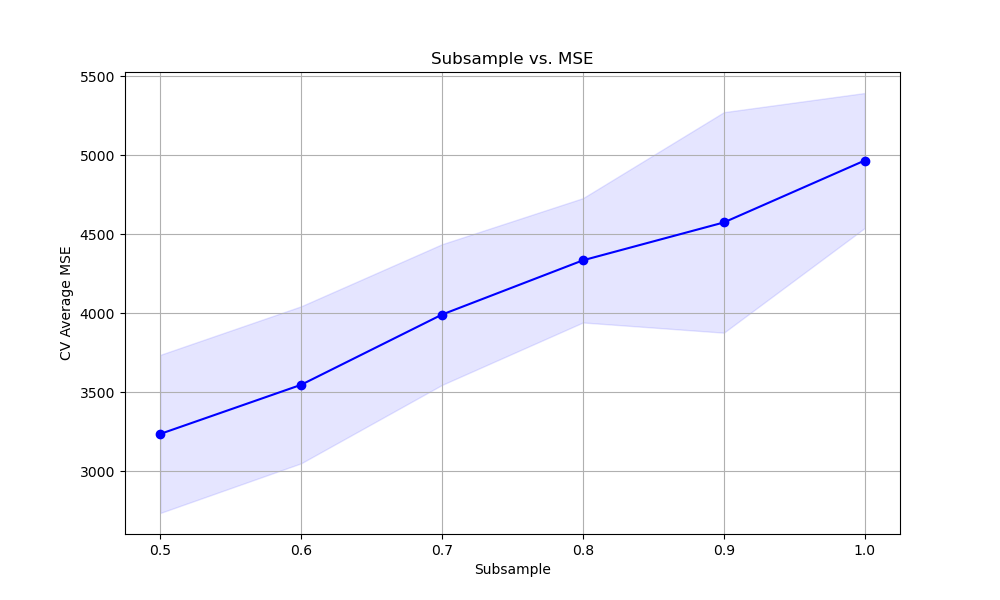The subsample parameter in XGBoost controls the fraction of training samples used in each iteration of the boosting process.
It introduces randomness into the training process, which can help prevent overfitting and improve generalization. Smaller values of subsample use fewer samples per iteration, introducing more diversity across the ensemble of trees, while larger values use more samples, making each tree more similar to the others.
This example demonstrates how to tune the subsample hyperparameter using grid search with cross-validation to find the optimal value that balances model performance and training time.
import xgboost as xgb
import numpy as np
from sklearn.datasets import make_regression
from sklearn.model_selection import GridSearchCV, KFold
from sklearn.metrics import mean_squared_error
# Create a synthetic dataset
X, y = make_regression(n_samples=1000, n_features=20, noise=0.1, random_state=42)
# Configure cross-validation
cv = KFold(n_splits=5, shuffle=True, random_state=42)
# Define hyperparameter grid
param_grid = {
'subsample': [0.5, 0.6, 0.7, 0.8, 0.9, 1.0]
}
# Set up XGBoost regressor
model = xgb.XGBRegressor(n_estimators=100, learning_rate=0.1, random_state=42)
# Perform grid search
grid_search = GridSearchCV(estimator=model, param_grid=param_grid, cv=cv, scoring='neg_mean_squared_error', n_jobs=-1, verbose=1)
grid_search.fit(X, y)
# Get results
print(f"Best subsample: {grid_search.best_params_['subsample']}")
print(f"Best CV MSE: {-grid_search.best_score_:.4f}")
# Plot subsample vs. MSE
import matplotlib.pyplot as plt
results = grid_search.cv_results_
plt.figure(figsize=(10, 6))
plt.plot(param_grid['subsample'], -results['mean_test_score'], marker='o', linestyle='-', color='b')
plt.fill_between(param_grid['subsample'], -results['mean_test_score'] + results['std_test_score'],
-results['mean_test_score'] - results['std_test_score'], alpha=0.1, color='b')
plt.title('Subsample vs. MSE')
plt.xlabel('Subsample')
plt.ylabel('CV Average MSE')
plt.grid(True)
plt.show()
The resulting plot may look as follows:

In this example, we create a synthetic regression dataset using scikit-learn’s make_regression function. We then set up a KFold cross-validation object to split the data into training and validation sets.
We define a hyperparameter grid param_grid that specifies the range of subsample values we want to test. In this case, we consider values from 0.5 to 1.0.
We create an instance of the XGBRegressor with some basic hyperparameters set, such as n_estimators and learning_rate. We then perform the grid search using GridSearchCV, providing the model, parameter grid, cross-validation object, scoring metric (negative mean squared error), and the number of CPU cores to use for parallel computation.
After fitting the grid search object with grid_search.fit(X, y), we can access the best subsample value and the corresponding best cross-validation mean squared error using grid_search.best_params_ and grid_search.best_score_, respectively.
Finally, we plot the relationship between the subsample values and the cross-validation average mean squared error scores using matplotlib. We retrieve the results from grid_search.cv_results_ and plot the mean MSE scores along with the standard deviation as error bars. This visualization helps us understand how the choice of subsample affects the model’s performance and guides us in selecting an appropriate value.
By tuning the subsample hyperparameter using grid search with cross-validation, we can find the optimal value that balances the model’s performance and training time. This helps prevent overfitting and ensures that the model generalizes well to unseen data while also considering computational efficiency.
